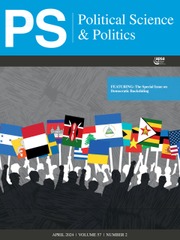Crossref Citations
This article has been cited by the following publications. This list is generated based on data provided by
Crossref.
Masuoka, Natalie
Grofman, Bernard
and
Feld, Scott L.
2007.
Ranking Departments: A Comparison of Alternative
Approaches.
PS: Political Science & Politics,
Vol. 40,
Issue. 3,
p.
531.
Barnett, George A.
Danowski, James A.
Feeley, Thomas Hugh
and
Stalker, Jordan
2010.
Measuring Quality in Communication Doctoral Education Using Network Analysis of Faculty-Hiring Patterns.
Journal of Communication,
Vol. 60,
Issue. 2,
p.
388.
Ghoshal, Gourab
and
Barabási, Albert-László
2011.
Ranking stability and super-stable nodes in complex networks.
Nature Communications,
Vol. 2,
Issue. 1,
Barnett, George A.
and
Feeley, Thomas Hugh
2011.
Comparing the NRC and the Faculty Hiring Network Methods of Ranking Doctoral Programs in Communication.
Communication Education,
Vol. 60,
Issue. 3,
p.
362.
Weakliem, David L.
Gauchat, Gordon
and
Wright, Bradley R. E.
2012.
Sociological Stratification: Change and Continuity in the Distribution of Departmental Prestige, 1965–2007.
The American Sociologist,
Vol. 43,
Issue. 3,
p.
310.
Liu, Xingjian
and
Zhan, F. Benjamin
2012.
Productivity of Doctoral Graduate Placement Among PhD-Granting Geography Programs in the United States: 1960–2010.
The Professional Geographer,
Vol. 64,
Issue. 4,
p.
475.
Ishiyama, John
Balarezo, Christine
and
Miles, Tom
2014.
Do Graduate Student Teacher Training Courses Affect Placement Rates?.
Journal of Political Science Education,
Vol. 10,
Issue. 3,
p.
273.
Mai, Bo
Liu, Jiaying
and
Gonzalez-Bailon, Sandra
2015.
Network Effects in the Academic Market: Mechanisms for Hiring and Placing PhD's in Communication (2007-2014).
SSRN Electronic Journal,
Singh Chouhan, Jayendra
and
Gadwal, Anand
2015.
Improving web search user query relevance using content based page rank.
p.
1.
Clauset, Aaron
Arbesman, Samuel
and
Larremore, Daniel B.
2015.
Systematic inequality and hierarchy in faculty hiring networks.
Science Advances,
Vol. 1,
Issue. 1,
Mai, Bo
Liu, Jiaying
and
González-Bailón, Sandra
2015.
Network Effects in the Academic Market: Mechanisms for Hiring and Placing PhDs in Communication (2007-2014).
Journal of Communication,
Vol. 65,
Issue. 3,
p.
558.
Hesli Claypool, Vicki
and
Mershon, Carol
2016.
Does diversity matter? Evidence from a survey of political science faculty.
Politics, Groups, and Identities,
Vol. 4,
Issue. 3,
p.
483.
Kim, Kiyoung
Borhanian, Shahin
Chung, Koo-Tae
Park, Yong-Hyun
Lee, Won-Sang
and
Kim, Jae-Hyung
2016.
The Graduate Law Degree Holders in the Legal Education Market: Evidence from the US, Rankings and Implications.
Beijing Law Review,
Vol. 07,
Issue. 04,
p.
371.
Speakman, Robert J.
Hadden, Carla S.
Colvin, Matthew H.
Cramb, Justin
Jones, K. C.
Jones, Travis W.
Lulewicz, Isabelle
Napora, Katharine G.
Reinberger, Katherine L.
Ritchison, Brandon T.
Edwards, Alexandra R.
Thompson, Victor D.
and
Hart, John P.
2018.
Market share and recent hiring trends in anthropology faculty positions.
PLOS ONE,
Vol. 13,
Issue. 9,
p.
e0202528.
Brookes, Stuart
and
Huynh, Hoai Nguyen
2018.
Transport networks and towns in Roman and early medieval England: An application of PageRank to archaeological questions.
Journal of Archaeological Science: Reports,
Vol. 17,
Issue. ,
p.
477.
Shanmugam, K.
and
Karthikeyani, V
2019.
Piping “personalized PageRank” Algorithm from the Analytic Hierarchy Process(AHP) – A Case study.
p.
56.
del Castillo, Enrique
Meyers, Adam
and
Chen, Peng
2020.
Exponential random graph modeling of a faculty hiring network: The IEOR case.
IISE Transactions,
Vol. 52,
Issue. 1,
p.
43.
Wapman, K. Hunter
Zhang, Sam
Clauset, Aaron
and
Larremore, Daniel B.
2022.
Quantifying hierarchy and dynamics in US faculty hiring and retention.
Nature,
Vol. 610,
Issue. 7930,
p.
120.
Frese, Joris
2023.
Academic placement records and gendered placements in the political science profession.
European Political Science,
Vol. 22,
Issue. 2,
p.
243.
Kazimer, Jeremy
De Domenico, Manlio
Mucha, Peter J.
and
Taylor, Dane
2024.
Ranking Edges by Their Impact on the Spectral Complexity of Information Diffusion over Networks.
Multiscale Modeling & Simulation,
Vol. 22,
Issue. 3,
p.
925.

